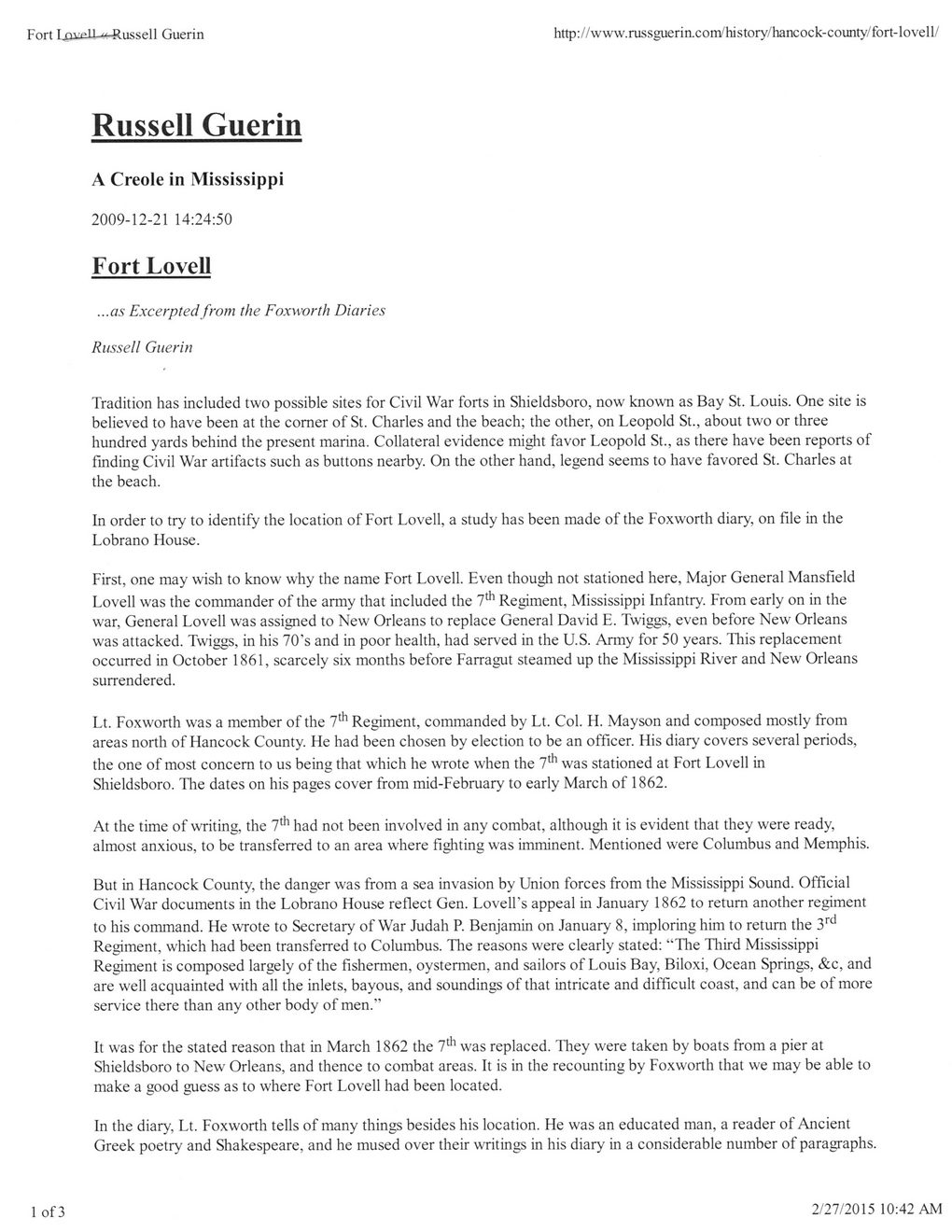This text was obtained via automated optical character recognition.
It has not been edited and may therefore contain several errors.
Fort Lavpll .'-Russell Guerin http://www.russguerin.com/history/hancock-county/fort-lovell/ Russell Guerin A Creole in Mississippi 2009-12-21 14:24:50 Fort Lovell ...as Excerpted from the Foxworth Diaries Russell Guerin Tradition has included two possible sites for Civil War forts in Shieldsboro, now known as Bay St. Louis. One site is believed to have been at the comer of St. Charles and the beach; the other, on Leopold St., about two or three hundred yards behind the present marina. Collateral evidence might favor Leopold St., as there have been reports of finding Civil War artifacts such as buttons nearby. On the other hand, legend seems to have favored St. Charles at the beach. In order to try to identify the location of Fort Lovell, a study has been made of the Foxworth diary, on file in the Lobrano House. First, one may wish to know why the name Fort Lovell. Even though not stationed here, Major General Mansfield Lovell was the commander of the army that included the 7th Regiment, Mississippi Infantry. From early on in the war, General Lovell was assigned to New Orleans to replace General David E. Twiggs, even before New Orleans was attacked. Twiggs, in his 70's and in poor health, had served in the U.S. Army for 50 years. This replacement occurred in October 1861, scarcely six months before Farragut steamed up the Mississippi River and New Orleans surrendered. Lt. Foxworth was a member of the 7th Regiment, commanded by Lt. Col. H. Mayson and composed mostly from areas north of Hancock County. He had been chosen by election to be an officer. His diary covers several periods, the one of most concern to us being that which he wrote when the 7th was stationed at Fort Lovell in Shieldsboro. The dates on his pages cover from mid-February to early March of 1862. At the time of writing, the 7th had not been involved in any combat, although it is evident that they were ready, almost anxious, to be transferred to an area where fighting was imminent. Mentioned were Columbus and Memphis. But in Hancock County, the danger was from a sea invasion by Union forces from the Mississippi Sound. Official Civil War documents in the Lobrano House reflect Gen. Lovell's appeal in January 1862 to return another regiment to his command. He wrote to Secretary of War Judah R Benjamin on January 8, imploring him to return the 3rd Regiment, which had been transferred to Columbus. The reasons were clearly stated: ?The Third Mississippi Regiment is composed largely of the fishermen, oystermen, and sailors of Louis Bay, Biloxi, Ocean Springs, &c, and are well acquainted with all the inlets, bayous, and soundings of that intricate and difficult coast, and can be of more service there than any other body of men.? It was for the stated reason that in March 1862 the 7th was replaced. They were taken by boats from a pier at Shieldsboro to New Orleans, and thence to combat areas. It is in the recounting by Foxworth that we may be able to make a good guess as to where Fort Lovell had been located. In the diary, Lt. Foxworth tells of many things besides his location. He was an educated man, a reader of Ancient Greek poetry and Shakespeare, and he mused over their writings in his diary in a considerable number of paragraphs. 1 of 3 2/27/2015 10:42 AM

Fort Lovell Russell-Guerin-Article-(2009)-1